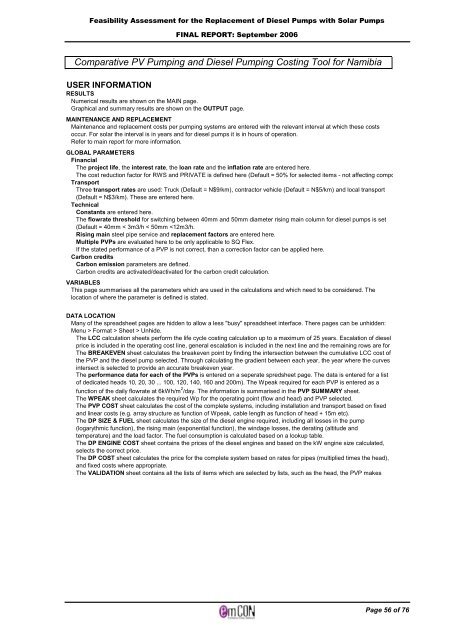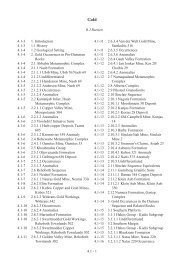Solar PV water pumping study - FINAL REPORT ... - UNDP, Namibia
Solar PV water pumping study - FINAL REPORT ... - UNDP, Namibia
Solar PV water pumping study - FINAL REPORT ... - UNDP, Namibia
You also want an ePaper? Increase the reach of your titles
YUMPU automatically turns print PDFs into web optimized ePapers that Google loves.
Feasibility Assessment for the Replacement of Diesel Pumps with <strong>Solar</strong> Pumps<br />
<strong>FINAL</strong> <strong>REPORT</strong>: September 2006<br />
Comparative <strong>PV</strong> Pumping and Diesel Pumping Costing Tool for <strong>Namibia</strong><br />
USER INFORMATION<br />
RESULTS<br />
Numerical results are shown on the MAIN page.<br />
Graphical and summary results are shown on the OUTPUT page.<br />
MAINTENANCE AND REPLACEMENT<br />
Maintenance and replacement costs per <strong>pumping</strong> systems are entered with the relevant interval at which these costs<br />
occur. For solar the interval is in years and for diesel pumps it is in hours of operation.<br />
Refer to main report for more information.<br />
GLOBAL PARAMETERS<br />
Financial<br />
The project life, the interest rate, the loan rate and the inflation rate are entered here.<br />
The cost reduction factor for RWS and PRIVATE is defined here (Default = 50% for selected items - not affecting component capital cost).<br />
Transport<br />
Three transport rates are used: Truck (Default = N$9/km), contractor vehicle (Default = N$5/km) and local transport<br />
(Default = N$3/km). These are entered here.<br />
Technical<br />
Constants are entered here.<br />
The flowrate threshold for switching between 40mm and 50mm diameter rising main column for diesel pumps is set<br />
(Default = 40mm < 3m3/h < 50mm Format > Sheet > Unhide.<br />
The LCC calculation sheets perform the life cycle costing calculation up to a maximum of 25 years. Escalation of diesel<br />
price is included in the operating cost line, general escalation is included in the next line and the remaining rows are for<br />
The BREAKEVEN sheet calculates the breakeven point by finding the intersection between the cumulative LCC cost of<br />
the <strong>PV</strong>P and the diesel pump selected. Through calculating the gradient between each year, the year where the curves<br />
intersect is selected to provide an accurate breakeven year.<br />
The performance data for each of the <strong>PV</strong>Ps is entered on a seperate spredsheet page. The data is entered for a list<br />
of dedicated heads 10, 20, 30 ... 100, 120, 140, 160 and 200m). The Wpeak required for each <strong>PV</strong>P is entered as a<br />
function of the daily flowrate at 6kWh/m 2 /day. The information is summarised in the <strong>PV</strong>P SUMMARY sheet.<br />
The WPEAK sheet calculates the required Wp for the operating point (flow and head) and <strong>PV</strong>P selected.<br />
The <strong>PV</strong>P COST sheet calculates the cost of the complete systems, including installation and transport based on fixed<br />
and linear costs (e.g. array structure as function of Wpeak, cable length as function of head + 15m etc).<br />
The DP SIZE & FUEL sheet calculates the size of the diesel engine required, including all losses in the pump<br />
(logarythmic function), the rising main (exponential function), the windage losses, the derating (altitude and<br />
temperature) and the load factor. The fuel consumption is calculated based on a lookup table.<br />
The DP ENGINE COST sheet contains the prices of the diesel engines and based on the kW engine size calculated,<br />
selects the correct price.<br />
The DP COST sheet calculates the price for the complete system based on rates for pipes (multiplied times the head),<br />
and fixed costs where appropriate.<br />
The VALIDATION sheet contains all the lists of items which are selected by lists, such as the head, the <strong>PV</strong>P makes<br />
Page 56 of 76




